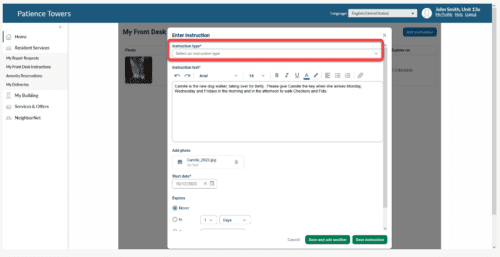Summary: Having emergency procedures at your fingertips when calamity strikes makes it easier to keep everyone in your building safe from harm. BuildingLink’s front desk instruction module makes it easy to have emergency procedures close to hand when they’re needed most.
No one wants disaster to strike. But if it does, it’s best to be prepared with emergency procedures. Whether it’s fire, flood, storms or bomb threats, knowing how to respond is crucial for surviving unexpected calamities. A step-by-step emergency response manual with front desk instructions can make the difference between life and death.
Many of us think we’d respond well in an emergency. The truth is, just 10 to 15% of people quickly understand the situation and act safely in an emergency. The rest of us panic, become paralysed with fear, deny the danger or follow the crowd. That’s why emergency procedures are so important.
BuildingLink makes it easier to access the right procedures in an emergency. By storing emergency procedures with front desk instructions, building managers and their teams can quickly and easily find the right guides when they need them.
What emergency procedures should be in place for multi-family buildings?
Emergency response procedures should cover all expected emergency events. These can include:
- Fires in the building
- Bushfires/fires outside the building
- Cyclones and high-intensity storms
- Bomb threats
- Biological mail threats
- Medical emergencies
- Earthquakes
Building management teams should store emergency manuals digitally and keep printed copies in easily accessible places in case electronic systems go down.
Emergency responses tend to fall into three categories – evacuating the building, sheltering in place, and securing part of the building or the situation while waiting for help to arrive. One emergency response procedure can be used for multiple situations, such as sheltering in place for a cyclone or an earthquake.
Queensland’s Office of the Information Commissioner has an excellent emergency response procedure that can be used to create your own building’s emergency response manual.
How to create emergency procedures as front desk instructions
To create new emergency procedures as front desk instructions, add a new instruction to the Front Desk Module and note the type of instruction.
In the box below the instruction type, provide details about the emergency procedure. Listing the actions that need to be taken in order is a great way to make sure nothing is forgotten when disaster strikes.

With emergency guides, there is no need to include start or end dates. Instead, click the ‘Never’ radio button under the expiry date section.
Once front desk instructions have been created and saved for front desk staff, review them with your team. This builds familiarity with the emergency steps you’ll take. That increases the likelihood that your management team will become part of the 10-15% group responding well in an emergency!
BuildingLink’s front desk instruction module puts everything management teams need at their fingertips – no matter how urgent the situation is. Book a demo today and find out how we can help keep your building safe.
